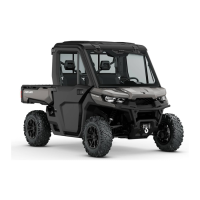PREPARE TO RIDE
Use tinted face shields or goggles in
the daytime only; do not use them at
night or in poor illum ination. Do not
use them if the y impa ir your ability to
discern color.
Other Riding Gear
Footwear
Always w ear c los ed toe footwear.
Sturdy over-the-ankle boots with
non-slip soles offer more protection
and allow you to plant your foot prop-
erly on footrest.
Avoid long shoelaces that can be tan-
gled in the accelerator or brake pedals.
For winter riding conditions, rubber
soled boots with either a nylon or
leather upp e rs , with re m ovable felt
liners are best suited.
Avoid rubber boots. Rubber boots may
get trapped behind or between pedals,
impairing the proper operation of brake
and accelerator pedals.
Gloves
Full-fingered gloves protect hands
from the wind, sun, heat, cold and fly-
ing ob jects. Gloves that fit snugly will
improvegriponthesteeringwheeland
help reduce hand fatigue. Sturdy, rein-
forced motorcycle or ATV gloves help
protect hands bette r in the event of an
accident or a rollover. If gloves are too
bulky, it may be difficult to operate the
controls.
For winter riding conditions, hands
should be protected by a pair of snow-
mobile gloves which have sufficient
insulation and allow use of thumbs and
fingers for operation of controls.
Jackets, Pants and Riding Suits
Wear a jacket or a long sleeved shirt
and long pants, or a full riding suit.
Quality ATV-type p ro tective gear will
provide comfort, and it can help you
avoid being distracted by adverse en-
vironmental elements. In case of a
crash, good quality protective gear
made of sturdy material may prevent
or reduce injury.
In cool-weather riding, protect your-
self against hypothermia. Hypother-
mia, a condition of low body tempera-
ture, can cause loss of concentration,
slowed reactions and loss of smooth,
precise muscle mov ement. In cool
conditions, proper protective gear like
a windproof jacket and insulated layers
of clothing are essential. Even while
riding at moderate temperatures, you
can feel very cold due to the wind.
Protective gear that is appropriate for
cold-weather riding may be too hot
when stopped. Dress in layers so that
clothing can be rem oved as desired.
To pping the protective gear w ith a
windproof outer layer can prevent cold
air from reaching the skin.
Rain Gear
Ifyoumustrideinwetweather,arain
suit or a w aterproof riding suit is rec-
ommended. On long rides, it is a good
idea to carry rain gear. A dry rider will
be much more comfortable and alert.
Hearing Protection
Long-term exposure to wind and en-
gine noise when riding can cause per-
manent hearing loss. Properly worn
hearing protective devices such as
earplugs can help prevent hearing loss.
Check local laws before using any hear-
ing protective devices.
18
_______
SAFETY I
NFORMATION
________

